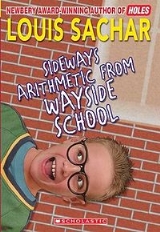
Sideways Arithmetic From Wayside School
Encyclopedia
Sideways Arithmetic From Wayside School is a children's
novel
by Louis Sachar
in the Sideways Stories From Wayside School
series. The book primarily contains mathematical and logical puzzles for the reader to solve.
. Chapter 1 has 11 problems all about adding and subtracting using words.
In the next chapter, Sue complains that they're not supposed to do math that way, and says a few problems for example, seven + four = eleven), which Mrs. Jewls states is impossible, and the reader has to figure out why the problems Sue mentioned are impossible. In the next chapter, Mrs. Jewls tells Sue that if she doesn't understand how to do math here, she should change to a different school, but when Sue inadvertently gets a question correct, Mrs. Jewls lets her stay. Chapter 4 also contains multiplication problems. Chapter 5 is about recess, where after a storyline is told, the students have to figure the answer of a few questions about what happened at recess. Chapter 6 involves involves Mrs. Jewls having trouble filling out report card
s because she doesn't have all the grades, so she needs to figure out the answers on the quizzes in order to grade the students. Chapter 7 involves more logical questions, and Chapter 8 presents the reader with "true or false" tests in which the assertions refer to themselves. The last chapter is about Sue finally making a new friend, Joy, and they go home together after school.
Children's literature
Children's literature is for readers and listeners up to about age twelve; it is often defined in four different ways: books written by children, books written for children, books chosen by children, or books chosen for children. It is often illustrated. The term is used in senses which sometimes...
novel
Novel
A novel is a book of long narrative in literary prose. The genre has historical roots both in the fields of the medieval and early modern romance and in the tradition of the novella. The latter supplied the present generic term in the late 18th century....
by Louis Sachar
Louis Sachar
Louis Sachar is an American author of children's books who is best known for the Sideways Stories From Wayside School book series and the 1998 novel Holes, for which Sachar won a National Book Award and the Newbery Medal...
in the Sideways Stories From Wayside School
Sideways Stories From Wayside School
The Sideways Stories From Wayside School series is a popular series of 3 books by Louis Sachar. Sideways Stories From Wayside School, Wayside School is Falling Down and Wayside School Gets A Little Stranger are the three novel-length books...
series. The book primarily contains mathematical and logical puzzles for the reader to solve.
Plot
The first chapter introduces Sue, a new student in Mrs. Jewls's class. She is bewildered to discover that the arithmetic lessons involve adding words instead of numbers, using verbal arithmeticVerbal arithmetic
Verbal arithmetic, also known as alphametics, cryptarithmetic, crypt-arithmetic, cryptarithm or word addition, is a type of mathematical game consisting of a mathematical equation among unknown numbers, whose digits are represented by letters. The goal is to identify the value of each letter...
. Chapter 1 has 11 problems all about adding and subtracting using words.
In the next chapter, Sue complains that they're not supposed to do math that way, and says a few problems for example, seven + four = eleven), which Mrs. Jewls states is impossible, and the reader has to figure out why the problems Sue mentioned are impossible. In the next chapter, Mrs. Jewls tells Sue that if she doesn't understand how to do math here, she should change to a different school, but when Sue inadvertently gets a question correct, Mrs. Jewls lets her stay. Chapter 4 also contains multiplication problems. Chapter 5 is about recess, where after a storyline is told, the students have to figure the answer of a few questions about what happened at recess. Chapter 6 involves involves Mrs. Jewls having trouble filling out report card
Report card
A report card communicates a student's performance. In most places, the report card is issued by the school to the student or the student's parents twice or four times yearly. A typical report card uses a grading scale to determine the quality of a student's school work...
s because she doesn't have all the grades, so she needs to figure out the answers on the quizzes in order to grade the students. Chapter 7 involves more logical questions, and Chapter 8 presents the reader with "true or false" tests in which the assertions refer to themselves. The last chapter is about Sue finally making a new friend, Joy, and they go home together after school.

